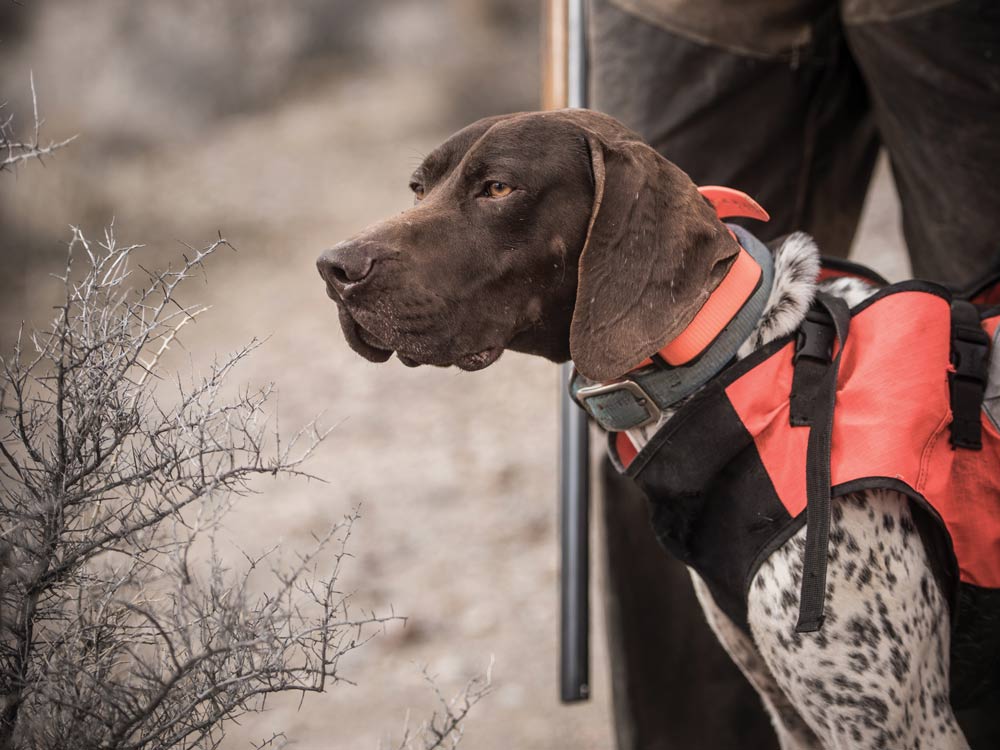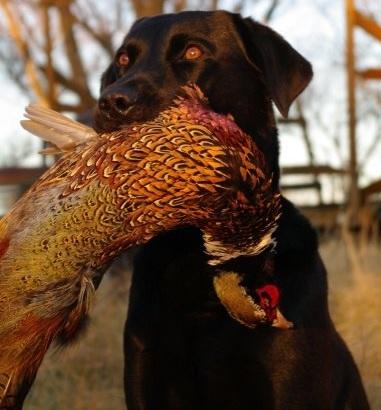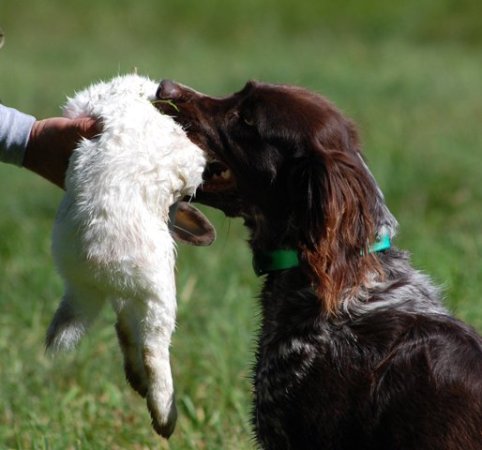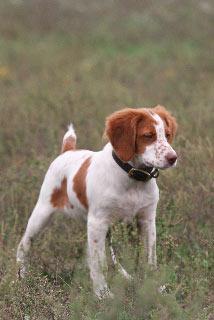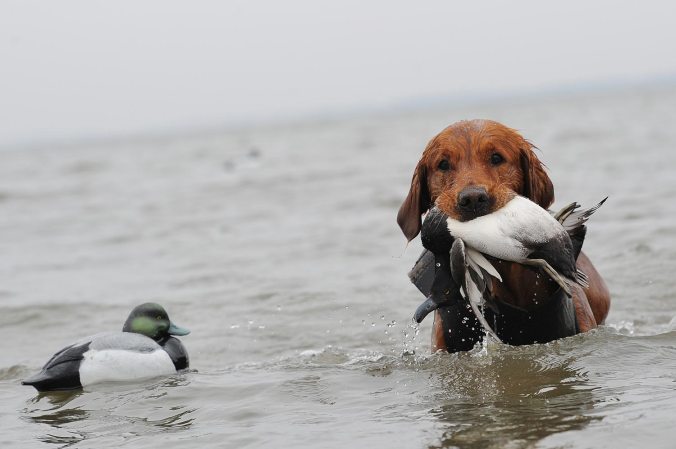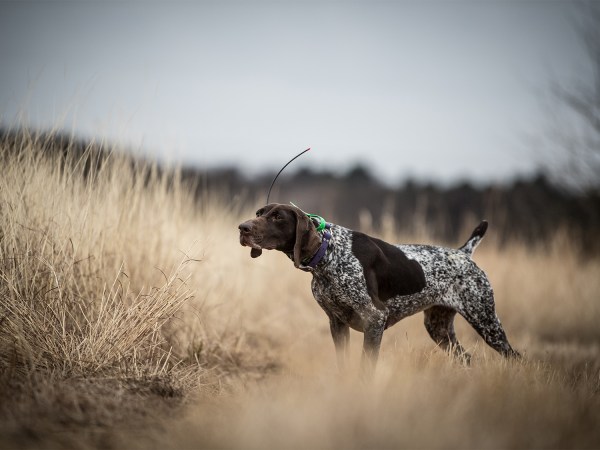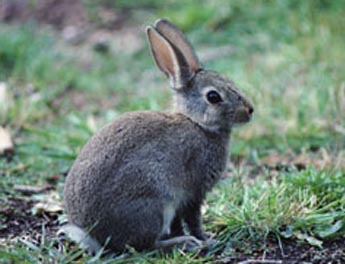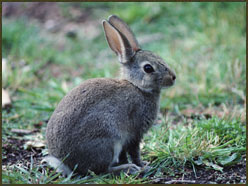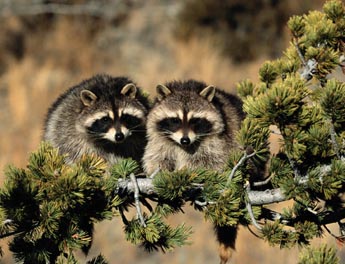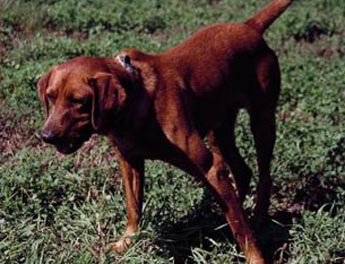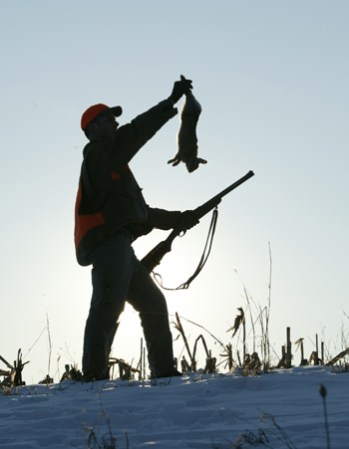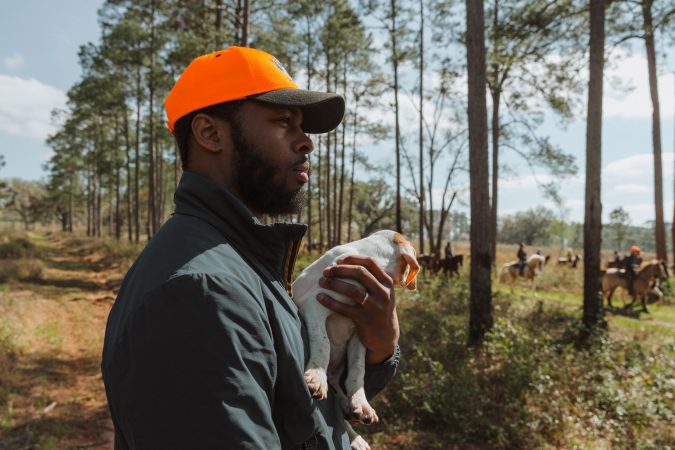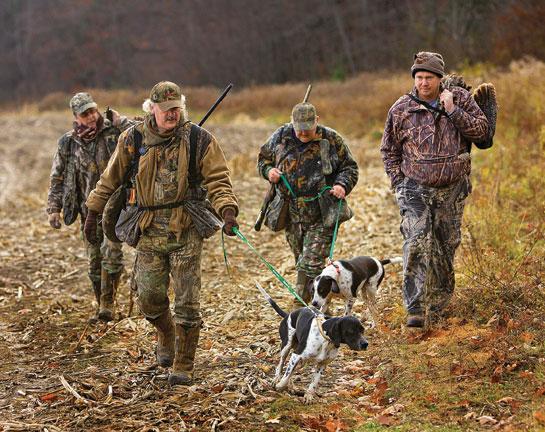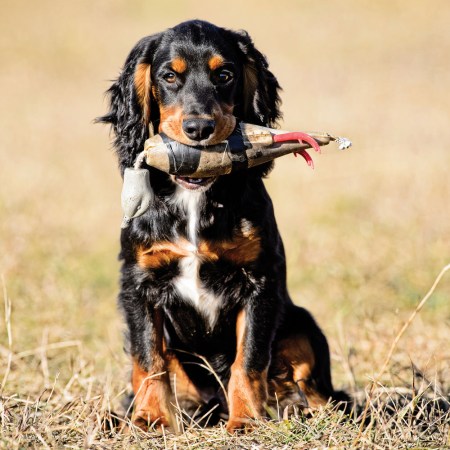Discussing the best breed of hunting dog for various game is kind of like arguing whether a Chevy or Ford is better. But, we’re going to take a crack at putting some definition to the hunting dogs discussion.
While many breeds can be hunted on several species of quarry, we’re going to only use a breed of hunting dog once—forcing us to choose wisely which breed we’d want if pursuing that animal. This will allow us to cover a wide range of breeds and give you a better idea of the strengths of each dog. Thus hunting dog guide will make picking out your next pup easier.
1. Labs Are Best For Ducks
Without a doubt, the best all-around waterfowl dog you can find, Labradors were bred for marking, retrieving, and delivering waterfowl to a hunter’s hand.
Their physical attributes make them perfect for cold-water retrieving: a double coat for warmth and water repellency; webbed feet; a compact, muscled body; a thick otter tail for balance and maneuverability in the water.
As perfectly suited physically as they are for swimming and retrieving, what separates the Labrador from other retrieving breeds is its intelligence. In particular, Labradors mature faster than other breeds, which allow them to grasp training at a younger age and handle the learning curve of taking whistle and hand signals at great distances while performing blind retrieves, as well as the complex concepts involved in field trials.
They’re the most registered dog in America for both their prowess in the field and their disposition in the home. They’re the all-American dog that can hunt all day and then come home and play with the kids.
READ NEXT: The Best Duck Hunting Dogs
2. Springer Spaniels Have an Edge Over Pointers
If I couldn’t have a Lab in the pheasant fields, I’d be tempted to take a German shorthair pointer – they’re great dogs with the stamina to cover ground all day long and the nose to point birds. But, because of the run-and-gun nature of pheasants (not to mention the tricks an experienced rooster can pull), and the fact that unlike quail you can’t shoot hens, I prefer a flushing dog over a pointing one. So, I’m going with the English springer spaniel.
Springers can course an upland field – be it corn, CRP or cattails – and put birds up with the best of any breed (they also do a fine job in the waterfowl realm). Smaller in size than either a Lab or GSP, springers have no problem covering ground on the hunt thanks to their abundant energy level. Their retrieving instinct is stronger than pointing breeds – a boon when a winged rooster makes a run for it.
With a good nose, an overall pleasant temperament and a biddable disposition, springers are loyal dogs that work hard and want to please their owners.
3. The Ultimate Grouse Dog
There isn’t a more regal-looking dog than an English setter and no more classic scene than the heavily feathered dog on point in the grouse woods. When it comes to good grouse dogs, a nose keen enough to scent the spooky birds without bumping them is the number-one requirement.
Setters, with their propensity to work closer than an English pointer, will stay in sight, holding a point which allows the hunter to get into position and ready a shot. When shooting at near ghosts in the thick forests of the upper Midwest and Northeast, a second or two head start with an inkling of direction can make all the difference a in hit bird and a whirling flush that only scares the bejesus out of you. After that shot, finding a downed grouse can be a challenge, so make sure your setter enjoys retrieving and force fetch him to cement that command.
Like many dogs who have seen their popularity rise, English setters have two distinct lines: conformation and field. For hunters, the smaller, more lightly feathered field line is the only way to go. An interesting setter fact: an English setter named Adonis was the first dog registered with the American Kennel Club.
4. Chesapeake Bay Retrievers Are Tough as Hell
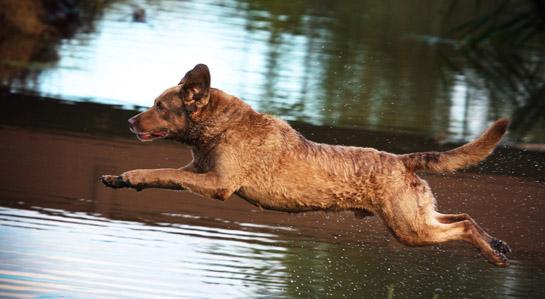
The only retriever bred completely within the U.S., Chessies embody the American hunter: hard working and utilitarian. Used to ply the cold, rough waters of the Chesapeake Bay during the market-hunting days, Chessies picked up the hordes of waterfowl shot by hunters wielding punt guns. They were then tasked with protecting the guns, gear, and boat at the docks while the hunters caroused in waterfront saloons – a one-man dog trait retained to this day.
Chesapeakes are more solidly built than Labs, and have a thick and oily coat to help repel cold seawater, as well as webbed feet for swimming. They love to swim and will repeatedly leap into icy water with eagerness to make retrieves. Their disposition – one of determination – makes them perfectly suited mentally for the tough task of sea-duck hunting.
A slower-maturing dog, Chessies can be tricky to train; you can’t use the same tactics as you would with a Labrador. Trainers must be more highly attuned to their dog, and know when they’re being obstinate and when they’re refusing commands out of confusion – it’s a fine line. That said, Chessies will perform all the tasks required of a waterfowl-hunting retriever, and they’ll do it in the harshest conditions. They’re also one of the few retrievers that maintains its hunting heritage completely; the conformation ring hasn’t completely created a separate line of the breed and dual champions are still possible to this day.
5. Pointers Were Built For Quail
The epitome of all pointing breeds, the slick, speedy and bird-obsessed “English” pointer won’t stop in its endless pursuit of feathers. With a sky-high prey drive, pointers will work the harshest territory in search of a covey – from Texas, where everything pricks, sticks or bites, to the humidity of a Georgia pine plantation. Their thin coat allows them to stay cool in the heat and their endurance ensures there’s enough dog for any hunt. In this capacity, they’re perfectly suited for the quail-rich South, but fair just as well in northern locations.
A wide range of lines exists for every hunter, from all-age field trial dogs that can perform for the horseback hunter to closer-working stock that might be desired by woodcock or grouse hunters. If you search them out, you can even find pointers (which are typically high energy dogs that only care about the hunt) that even make suitable family dogs.
Pointers have dominated the field-trial circuit at the highest levels for decades. They work hard, fast and possess a style rivaled only by the pageantry of setters. A well-trained pointer holding staunchly, with tail and head held high, is a sight that any dog man can appreciate—and that ability to lock on and hold for as long as necessary while a covey dances just off its nose is a testament to both the breed’s drive and trainability.
6. Run Beagles on Rabbits
Embodying the excitement of a rabbit hunt, beagles, with their incessant barking and baying, while in pursuit of a rabbit are often a kid’s first introduction to hunting dogs. They’re also the best canine for chasing bunnies in circles to give hunters a shot.
Diminutive and full of vigor and character, the tri-colored beagle has been used for small game hunting for nearly two hundred years. A scent hound, they possess one of the best noses in the canine world – the bloodhound is the indisputable leader of the pack when it comes to scenting abilities, with the basset hound and beagle following as close runner-ups. That supreme scenting ability, combined with speed and agility, make beagles the top choice for rabbits, and their propensity to bark ensures that you’ll never lose track of their whereabouts.
While beagles stand out when coursing the briar patches for bunnies, their scenting abilities are so keen that they’re used as detection dogs as well. Their even disposition and friendly demeanor make them a popular family pet (they held the AKC’s top-registration spot from 1953-59, and still rank in the top five), and because of their small size, beagles don’t need a large house or yard – giving even suburban-bound houndsmen a chance to get in on the chase.
7. Bred For Breaking Up Turkey Flocks
Humans have been selectively breeding canines to carry out specialized tasks for tens of thousands of years, and it doesn’t get much more specialized than breaking up flocks of fall turkeys.
While setters are a popular choice for many turkey doggers, it’s hard to argue against the logic and breeding of Appalachian turkey dogs. An unofficial breeding not recognized by the AKC, turkey dogs are a combination of setter, pointer, and Plott hound. Each purebred foundation stock contributes attributes to the turkey dog, among them: setters – stylish looks, drive for feathers, biddability; pointers – stamina, speed, prey drive, range; Plotts – desire to chase, track, bark.
A fall turkey dog needs to be a big runner that can track by air and ground scent or use its eyes to find flocks of birds. Once they do, they bust the flock and give chase while barking like a hound on scent, scattering birds in all directions so that the group is busted into singles. The dog then returns to the hunter and curls up and waits patiently; much like a waterfowl dog in the blind.
While I’m typically a skeptic when it comes to mixed breeds in the field (there are plenty of mutts that can get it done, but if you’re betting time and money, I prefer to play the odds), selective breeding for specific tasks has brought us nearly every breed in existence today – and the Appalachian turkey dog fills a hunting niche requiring specific attributes derived from each of the purebreds making up its lineage.
8. Stronger Than a Pit Bull
With feral pigs spreading across the country like the plague and committing as much as $1 billion in agriculture damage per year, every means of hunting the intelligent and fertile beast has been adopted – from recreational hunters sitting in a stand, to trapping, to using night vision and helicopters. To that end, man’s best friend has become an integral part of the hunting equation.
Typically, chase dogs find and pursue hogs until they decide to turn and fight. That’s when catch dogs move in and engage the tusked beasts, latching on to ears or any other appendage they can sink their teeth into, and hold them until the hunters arrive. Pit bulls are a popular choice for catch dogs, but the dogo Argentino is even better.
Larger and even more powerful and athletic than a pit bull, dogos were designed specifically for big-game hunting. Originating in South America, dogos were bred for hunting pumas and wild hogs. Imported into the U.S. in the 70s, they are perfectly suited for the hot climate and thick, rugged territory where hogs thrive – Texas, Georgia and California, in particular. Dogos have well-muscled bodies, a thin white coat and the stamina to go toe-to-toe with a surly boar.
As intimidating as they look, and as fierce as they are on the hunt, dogo Argentinos are equally as friendly and loyal in the home; selective breeding for hunting, rather than the fighting ring, is what keeps this breed from displaying aggressiveness toward people or other dogs – the function of running with chase dogs and hunting as a cooperative pack was a primary driver in their development.
9. George Washington’s Hounds
Few dogs share such a rich American history as the foxhound. Bred here in the U.S. from English foxhounds and a smattering of other breeds, they were the dog of choice for George Washington – and he is often credited as the father of the breed.
Developed in Maryland and Virginia (Washington’s stomping grounds) for fox hunting, the dogs are perhaps the best breed for running deer drives popular in the area to this day. To run deer successfully, you need a rangy, energetic dog with plenty of stamina, a good nose and a desire to sing his love of the hunt for all to hear – and that is the essence of the American foxhound. They pack well with other dogs and can put reluctant deer on their feet and keep them moving better than many other popular breeds, such as the shorter-leg beagle.
Unlike some other scent hounds, foxhounds are “running” hounds, as opposed to “treeing” hounds, and they love the chase much more than the end result of the hunt. As veteran outdoor writer Doug Howlett, who participates in deer drives in his home state of Virginia, says: “American foxhounds will run through hell to get a deer, or a fox for that matter.”
10. The Best All-Around Hound
Perhaps the best all-around hound, Walkers are prized for their great nose, prey drive, speed, voice and ability to chase down everything from cougars, bears, and coyotes to raccoons, squirrels, and deer. The granddaddy of all hounding sports however, is coon hunting, and it’s tough to argue the abilities of a Walker when it comes to putting them up a tree.
Walkers were bred in the U.S. and descend from foxhounds. They tend to be more “hot-nosed” than some other hounds, such as the bluetick coonhound, which makes them ideal for competition, as well as “quick” hunts; those that you don’t spend all night tracking a single animal across multiple counties.
With their distinctive bawl and chop, tenacious stamina and hot nose, Walkers will keep houndsmen in the coon action all night.
11. Bear-Hunting Hounds
When you chase black bears in their own habitat, you need a dog that’s smart, tough, gritty, and able to find old scent and track it. The Plott hound is the perfect dog to do that; they’re muscular, athletic and tenacious – on both the track and after cornering a bear (or cougar or wild hog). Their short, choppy barks when in pursuit allow the hunter to follow their direction but without impacting their ability chase.
Plotts can find old scent and track it over heavily wooded hill-and-dale that black bears call home. They’ll fight and tree a black bear in a pack or even by themselves (although it’s unadvisable to let them square-off alone). Descendents of German big-game dogs brought to the New World in 1750 and used for wild boar hunting, Plotts were developed in the U.S. – in North Carolina by the Plott family that still resides in the area and still breeds the dogs.
Recognized by the United Kennel Club since 1946, Plotts only received recognition from the American Kennel Club in 2006 – despite their lengthy and well-documented ancestry. But for houndsmen and big-game hunters, recognition by a governing board is of less concern than performance in the field … as it should be.
12. Cutting Cougar Tracks With a Bluetick
Perhaps the most elusive animal in North America, mountain lions, can live just about any place where there are enough deer to feed them. They prowl, almost invisibly, close to homes, towns, and near hunters, hikers, bikers, and campers. To track this big cat, you need a hound with a good nose and stamina. When cornered, the hound needs to have the tenacity to stand toe-to-toe with a powerful enemy capable of killing with ease.
The bluetick coonhound, can pick up an old trail – key when cutting cougar tracks – and follow it with just enough speed and more than enough staying power to corner a cat in a tree or on a cliff’s edge. The bluetick’s ball and chop keeps the cat moving, or bayed when the time comes.
Recognized by the AKC as a standalone breed in 1946 (they were originally categorized as foxhounds), blueticks are descended from the Bleu de Gascogne hound of southwest France, the English foxhound, the cur dog, the American foxhound, and the black and tan Virginia foxhound. Purposefully bred to be slower and colder-nosed than foxhounds, blueticks have enough athleticism to keep up with a cougar.
Read Next: How to Turn a Rescue Dog, a Couch-Potato Lab, or an Off-Breed Pup into a Hunting Dog
13. Cur Dogs are Driven to Squirrel Hunt
Bushytails. They’re often the first game a child is allowed to hunt, and they’re part of a rich hunting tradition – especially throughout the South and Midwest. You can hunt squirrels by spot and stalk – walking through the forest and sniping them; sitting and calling to the territorial rodents; or you can use dogs to locate and mark them and then take a shot.
Almost every dog enjoys chasing squirrels, and nearly any could be trained to bark up bushytails, but the curs and feists are bred to do so – and they do it with enthusiasm. The mountain cur, brought from Europe by settlers of Ohio, Kentucky, Virginia, Tennessee, Oklahoma, and Arkansas, historically hunted squirrels and raccoons. They’re an all-around dog that families used for hunting and protection. They’ve been a registered breed with the UKC since 1998.
Mountain curs dominate the Squirrel Dog World Championship, with two making the finals this year and both taking the top-two spots. Sharing a mixed ancestry with hounds, which contribute a great nose and voice, terriers, which added tenacity, and even some shepherd, which allowed the dog to be used for herding purposes, curs are distinctively American; a mix of breeds to be used for all purposes in the frontier wilderness.
14. GSPs Are Your Best Bet For Chukar
Chukar, the most frustrating and physically demanding upland bird to hunt in the country, require a dog with a good nose and the stamina to keep up. The Mr. Red Legs is notorious for running up the steepest, nastiest hillsides in an attempt to elude (or perhaps kill) hunters. Just as the hunter catches up to the bird at the crest, the birds take wing and fly to the bottom of the canyon just ascended.
To successfully hunt chukar, you need to be in shape and so does your dog. A pointing breed with an exceptional nose works best; the dog can pinpoint the birds without bumping them, giving the guns a chance at an in-range shot that doesn’t come as a complete surprise.
The German shorthair is the dog that can accomplish all of those tasks. It possesses the intelligence to learn to outwit the wily chukar, as well as a keen sense of smell to scent and point them from a safe distance. Perhaps as important as their scenting ability, their physical makeup allows them climb the rugged hills chukars call home and withstand the heat and brutal terrain.
Recognized by the AKC in 1930, shorthairs originated, not surprisingly, in Germany and were a combination of pointing bird dogs and hounds. While they’ll make hunting chukars a less brutal proposition, they’re an all-around bird dog adept at pointing (and even retrieving) everything from quail to pheasant.
How to Pick Your Next Hunting Dog Puppy
Choosing the ideal hunting dog isn’t about selecting an individual puppy. The real decision comes in picking its parents. Once you’ve chosen a sire and dam, you can simplify the actual puppy-picking decision by focusing on the sex and color you prefer. Then just reach in and grab a pup. They all have similar genetics, and at 6- to 8-weeks old, they reveal just a glimpse of their personality and demeanor.
So what should you look for in selecting the parents? Here are a few things to keep in mind:
Look for Desire
For a dog to hunt effectively, as well as handle the pressure of training, it has to want to do it. That disposition and desire is embedded in its DNA—you can’t instill it with training. The best hunting dogs come from field-bred stock. Look for parents that hunt extensively or compete in hunt tests or field trials. Avoid dogs that come from conformation lines. While a few show lines might be able to perform in the field, most of them just can’t cut it.
Chesapeake Bay Retrievers, as long as they also hunt or compete in field work, would probably be the only exception to that rule; they’re one of the only remaining breeds that haven’t been split by the politics and influence of the conformation ring and can compete in both worlds.
Preview Your Pup
Your puppy will inherit its body type and energy level from its parents. Consider that the vast majority of time spent with your dog won’t take place in the field, but at home and in the training yard. If the parents’ energy, body size or temperament wouldn’t work in your everyday life, neither will that of their offspring.
Get a Matched Set
A big, high-rolling sire paired with a small, mellow dam won’t produce average-size, medium-drive puppies; instead, body size and drive will be unclear, with no direct indication of which puppies inherited which traits. Look for a pair with similar physiques and energy levels–their puppies will be much more consistent.
Health Clearances
Consider breeding pairs that have been vetted for common problem areas–hips, elbows, eyes, heart, skin and muscles.
Also, know what, if anything, the breeder guarantees. If your pup suddenly comes down with hip problems, do you get a refund? Do you have to give the puppy back? Can you keep the pup, get a partial refund and spay/neuter the animal?
Remember, many maladies don’t show up until later in life, most guarantees will cover up to the time that a dog can be tested for a disorder (e.g., two years), and by that time the puppy will be part of the family. Are you going to be okay with giving it back?
While not foolproof, guarantees help both you and the breeder should something go genetically wrong. Just be sure to talk about it first and get a clear and concise explanation of how things are to work.

